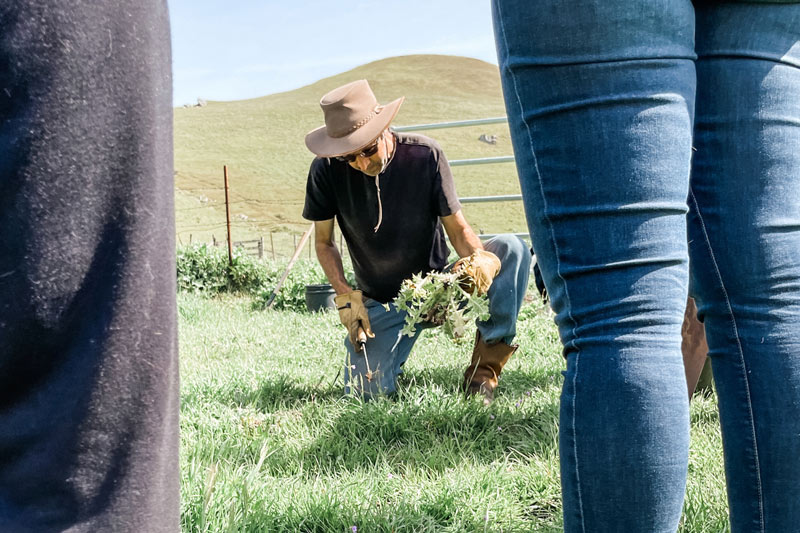Meet Sam Cohen, Marin’s Most Tenacious Weed Eater

By Matt Dolkas,
Senior Manager, Marketing
December 2, 2022
I’ve never met anyone quite like Sam Cohen.
Climbing out of his old Toyota pickup, it was hard to tell who was more excited for the day’s work, Sam, or his faithful herding dog, Buddy. A small group of MALT volunteers had congregated that day in front of his old sheep barn near Tomales. Huge clumps of invasive milk thistle (Silybum marianum) were erupting from the edges of the building and our objective for the day was to pull each painful plant by hand and help heal this portion of the ranch.
Since acquiring the 623-acre Hicks Canyon Ranch (formerly known as the Thatcher Ranch) in 2021, Sam has invested hundreds of hours working to control invasive species like milk thistle. If left untended, these invasive plants rapidly proliferate and can consume entire acres, degrading both the environmental quality as well as agricultural productivity of the landscape. Preserving the vibrancy of our local farmland depends, in part, on the tenacity of our efforts to control these invasive plants.


Why Are Invasive Weeds Such a Big Deal?
As an invasive plant takes over, it can create a monoculture under which native and desirable forage species can’t grow. This is especially an issue for insects who depend upon a diversity of vegetation. You might think fewer bugs would be a good thing, but insects are a critical part of the food chain, feeding everything from birds to fish and small mammals. In short, invasive weeds can strip the ecosystem of one of its most important ingredients—bugs.
Weeds can also play a detrimental role in the land’s ability to support agriculture. Thistles, for example, are something cattle just won’t eat, and too many in one paddock could compromise that land’s ability to support a local ranching operation and our community’s ability to produce local food. Protecting our farmland from the threat of invasive plants is part of the work required to protect our local food system and keep food on the table.

If left untended, invasive plants can proliferate and consume entire acres (as picture here), compromising both the land’s environmental quality and its ability to sustain agriculture.
Weeds Boom Amid Historic Drought
It’s difficult to fully comprehend the severity of the West’s current drought, the driest period in at least 1,200 years, fueled mostly by our rapidly changing climate. In the last three years, most Northern California cities have received only half to two thirds of their historic average, which is the equivalent of losing an entire year of rainfall. And with another La Niña year forecasted this winter, it’s looking to be yet another dry winter.
Weeds are taking advantage of these stressful times. From January to March of last year, for example, Northern California experienced one of its longest mid-winter dry periods in recorded history, a time when the state historically has received the majority of its annual rainfall. Grasses that typically proliferate during this wet season were stunted by the lack of rain and were quickly out-competed in places by the more tolerant invasive plants. This dry period was followed by an uncharacteristically wet late spring that gave weed populations a final boost. Climate change, it appears, is a good thing if you’re a highly invasive, ecosystem-threatening noxious weed.
Combatting weeds is a never-ending battle for Sam, the stains of which you can see on the knees of his tired Wranglers jeans from hours on the ground pulling sharp plants by hand. Here he demonstrates the best way to remove the highly invasive milk thistles.
A Zero Tolerance Policy
I’ve pulled a lot of weeds in my life but have never met anyone with the same attention to detail and dogged work ethic as Sam Cohen. As our group made their way through the thick patches of thistle, Sam made the rounds to be sure we were careful to extract the entire plant, head, leaves, stalk, roots and all. Even small traces of the roots could give the plant a foothold and a chance at survival. To win this fight, we learned, we had to be as tenacious as the weeds themselves.
We paused for lunch about mid-day, enjoying the warm sun and a chance to listen to Sam’s stories about his double life as a rancher and entrepreneur in the climate movement. He’s dedicated his career to combatting the climate crises, and those ethics have translated to how he approaches his land’s management—a uniquely profound sense of responsibility. It came as no surprise he was the first to rouse our group back to work.
There’s work to tend to and no time to lose.